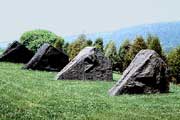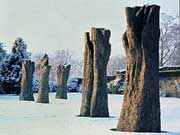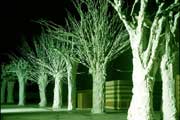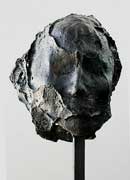|
"About my philosophy, my work and its
context"
I wanted to tell
you that
art is the
harmless activity of
mankind, but we recall
that art was often
used for propaganda
purposes by totalitarian
systems. - Art will
remain the most
astonishing activity of
mankind deriving from
constant struggle between
wisdom and madness,
between dream and
reality in our
mind.
Every scientific
discovery opens doors behind which are
other doors, closed. Art does not
solve problems but
makes us aware
of their existence.
It opens our eyes to see and
our brain to imagine. - To have
imagination and to be aware
of it means
to benefit from
possessing an inner
richness and a
spontaneous and endless
flood of images.
- It means to see the
world in its entirety, since the point of the images is to show all that which
escapes conceptualization. - To all the
fundamental fears of man,
I add my own.
They can perhaps
be glimpsed in
my art, which
is a story
of doubts and
uncertainties accompanying human
existence as well
as mine. - There is
an impressive continuity
in art´s witness
to man´s evolving
sense of reality. From time to time, a
civilisation falls from grace,
and art is destroyed
by fanaticism and wars; but some monuments remain along a path
that for hundreds of centuries is otherwise unmarked. Without the milestones of
his spiritual odyssey, man would be lost
in darkness. - Central-Eastern Europe, where I
live, represents a variety
of cultures, nationalities and
languages. The history of this
area is like
friable sands. States
are emerging and
disappearing. Capitals and borders
are moving. Wars are
replacing wars. Local
problems veil the
rest of the
globe. - Provincialism allows one to
look deeper and to reject
fashions. The ways
of expression are different
here, determined by
isolation, which allows for discovery.
ABAKANS:

After the last
world war, my country was destroyed like Hiroshima. We found ourselves under Soviet domination.
- Living area was
limited to one room per family. No place for art, no money, no materials, but I
was determined to build into this reality my own reality that would protect me. Soft objects
constructed of threads pulled out of old rejected ropes, soft sculptures that
one could roll and transform into small
packages to store anywhere. They were my first
environments, my reality, my first
spaces to experience, to contemplate. In the
countries deprived of
freedom, art was
a transmitter of
the desires of the nation. The
artist was a prophet of a better future. Art replaced politics, religion,
social science. It was sometimes the reason for punishment. This changed creativity
into a weapon stimulating resistance. - I built cages with
human bodies inside. This was my statement about constraint. One of them is in
the Museum of Contemporary Art in Chicago, others in Budapest and at the Lodz Museum of Modern Art.
CROWDS:

Then I created
headless crowds. I wanted to confront man with himself, with his solitude in
multitude. It happened that I lived
in times when the population of the planet increased 3 fold, when millions were
killed in wars, nations were and are manipulated by leaders. Theories and
philosophies justified the extermination of entire tribes and races.Crowds behave like
a brainless organism and act like a brainless organism, worshipping on command
and hating on command. I saw crowds trampling
themselves. - I suspect that
under the human skull, instincts and emotions overpower the intellect without
us being aware of it. Growing aggressiveness
has changed our reality. Terror, suicide bombers derive from despair in the
face of military might. Innocence does not protect anyone.
I visualise my
fears, building the fence of my immobile crowds between my reality and the
existing one. I bewitch the phenomenon of the crowd. I change it into the bridge
between all creations of nature.
In the seventies, I
began to cast human bodies in burlap. No commissions, no collectors, no
galleries. Burlap was like an image of the world under Soviet domination. Headless,
often handless, and shell-like, this was enough to say what I wanted. The
number of figures was growing year after year. With time, also in bronze,, aluminum
and iron. The entire population of standing, walking and seated figures - the Crowds,
the Flocks, and the others - are enough to fill a public square. There might be
over fifteen hundred, but they have never been seen together. - One can find them
in groups of 80, 250, 30, 50, 95, 112, in museums and collections in different parts of the world.
They constitute a sign of lasting anxiety, a warning.
I do not make
editions. Every figure is an individuality. There is also another
aspect of quantity: the law of nature which concerns us also.A crowd of people
or birds, insects or leaves, is a mysterious assemblage of variants of a
certain prototype. A riddle of nature´s abhorrence of exact repetition or
inability to produce it, just as the human hand cannot repeat its own gesture.
I invoke this disturbing law, switching my own immobile herds into that rhythm.
GRAIN OF SAND:
I immerse in the
crowd like a grain of sand in the friable sands. I am fading among the
anonymity of glances, movements, smells, in the common absorption of air, in
the common pulsation of juices under the skin. -I become a cell of
this boundless organism of the crowd, like others already integrated and
deprived of expression. - Destroying each
other, we regenerate. Through hate and love, we stimulate each other.
PUELLAE, BAMBINI, RAGAZZI:

The imagined is
stronger than reality or rather replaces it. - I remember: it was
the severe winter of 1942. The Germans occupied Poland. The war of Hitler with Russia continued. A transport of children from Poland to Germany, where they would be turned into Germans,
was stopped by accident
for a day and a night. The train was not heated. Hundreds of blond, blue-eyed
children, in the unheated cattle cars, froze to death. When finally soldiers
opened the doors, the bodies fell out stiff and hard like sculptures.
I wasn't there.
The
person telling me about this event built images in my childhood memory, clear,
strong and lasting.
Today I had to face
the terror attack in Chechnya, where hundreds of children were killed in their school on
the day their school year should have begun.
In Sudan, the extermination of hundreds of thousands dying of hunger
and violence is another image of childhood in our time. -
We are aware that the human family on our planet is no longer divided between
East and West, between those living under totalitarian and democratic systems.
Two thirds of the world population suffers from hunger and poverty. Poverty has
become a tourist attraction, something exotic, amusing, eagerly shown on
certain television channels.
WAR GAMES:

For a long time I
couldn't use wood. I saw it as a complete entity in itself.
Some years ago, I
suddenly discovered the inside of an old trunk with its core like a spine
entwined by channels of juices and nerves. I discovered the carnality of
another trunk with its limbs cut off, as if amputated. The fascination for
the body, the phenomenon of life, the
mystery of the construction of flesh, is behind the necessity to build my own
forms on the basis of existing ones. - And I wanted to
say: only the body is alive, in full, powerful and non-thinking. The head, the
arms, the hands are only intellectual articulation around the bulk of flesh
that is the body. It is there that we find the real universe hidden by the
universe of our perception.
SPACE TO EXPERIENCE:
I feel the reality
today to be related to those very early times when we wanted to communicate
with unknown powers, dividing spaces, raising stones, creating environments of
sacred meaning. A sculpture that carries energy, is not just a mean of
decorating a fireplace or a garden. It is a message, a language beyond
words.
I changed the
meaning of sculpture from object to look at into space to experience.
I built these
spaces in many countries, including Italy, Korea, Israel, Germany, Poland, Lithuania, the U.S.A.
These spaces allow
us to feel the meaning of the imagination of man confronted with the
imagination of nature. It is a coming together of two different powers: nature
does not pretend to create art. We do. What is the meaning of man's creativity
in comparison with nature's wisdom? - This coming
together of two realities is like a ceremony which we enter.
KATARSIS:

Is of a
material more lasting than life. Perhaps, because I hoped that the signs left
behind would be for others a lasting anxiety. Perhaps, it was a defiance of my
own views, an urge to question the accomplished. Perhaps an awareness that
constant immobility is stronger than changing situations.
SPACE OF DRAGON:

Our
feeling for space is established in early childhood.
I am used to the European space. In the Far East, I
was confronted by a totally different concept of space,
it´s meaning, it's use, and the role of art in
it. - I understood my ignorance in face of ZEN gardens
and the difference between theoretical knowledge of
history and tradition, and everyday practice.
|
SAGACIOUS HEADS:

SKULLS (Seoul Olympic Park, John Kluge Collection, Metropolitan)
- Head looks, Head eats, Head conveys.
Always
above or in front of the trunk, the head is first exposed to the unknown. It is responsible for the rest of the body, as a leader for his herd. - It informs about its experiences.
Separated from the trunk, the head becomes an entity. - Liberated from responsibilities, it preserves its wisdom.
HAND-LIKE
TREES:

I saw once hands stretched vertically, voting,
protesting, manifesting. - They were similar to branches moving in the wind. I
saw trees with branches stretched in a pompous movement, still and frozen but
so similar to hands.
SARCOPHAGI:

Sarx - phagein" - a coffin of limestone
from the region of Troy, which had the property of dissolving its contents
quickly. The Greek word Sarx-phagein means flesh eater. The word Sarcophagi
came into general use in the Roman - Empire as a name for a large coffin and is
now in use as an archaeological term. - Today sarcophagi are built for
dangerous technologies. A concrete sarcophagus covered the nuclear reactor at
the Chernobyl atomic power plant. I saw once hands stretched vertically, voting, protesting, manifesting. - They
were similar to branches moving in the wind. I saw trees with branches stretched in a pompous movement, still and frozen but so similar to hands.
NEGEV:

At the Israel
Museum, Jerusalem.
Today seen as symbol of peace and freedom. We worked on it together: the Bedouins, the Arabs, Curds and Israelis.
We worked in the Negev desert and then placing the big discs on the edge of the Jerusalem Sculpture Garden.
WHAT IS ARBOREAL ARCHITECTURE?


In 1991 Parisian authorities organized
a competition - "A Call for Ideas" concerning the extension of the historical
axis which crosses the city from the Louvre to the modern business district of
La Defense. The new section of the axis,
which was the subject of the competition, goes through the suburban town of Nanterre, situated between La Defense and the River Seine. It was to mark the western entrance to the
French capital. The organizers invited not
only architects but also artists. - I was among them.
Arriving in Paris - La Defense, I found
myself confronted by the "Grand Arche," a previously unknown to me enormous
rectangular frame, a building with different functions, 100 m tall and 100 m
wide, a rigid, cool geometry similar to a window. - It closed off the district of La Defense. -
I knew my shape must be organic,
vertical, huge, 100 m tall, a tree-like building.
And it must be followed by other tree-like
buildings. Many of them. An area of organic shapes which should be the new
western entrance to Paris: Arboreal Architecture! - Each of the arboreal buildings is a
vertical garden. The facade is enveloped
by trellises supporting the vegetation and being its irrigation system. Creepers and other plants chosen by
inhabitants would grow, beginning at the bottom and then at different levels of
the facade. Modern fertilizers allow for
growing vegetation in a minimum of soil. The air is clean. The greenery produces oxygen.
There are recreation areas with
swimming pools on the top of each building, as well as wind and solar energy
collectors. In the underground, in
the "roots," are parking garages,
commercial spaces, metro stations. My project was selected for further
development, but later vanished. I did
not find anybody with the courage, fantasy and curiosity of Francois Mitterand,
whose idea was to introduce new elements into the famous beauty of Paris.
STATEMENT:
On the geological clock indicating four billion years of our globe, human activity producing culture
occupies only the last few seconds. Within this span of time the human species has managed to threaten not only the biological and environmental balance, but also itself. What
is culture? Is it subject to development? Produced by tribes and nations, for centuries
it has been a shield. Civilisation -
which in time began to accompany culture as an embodiment of the quality of
existence - at the beginning of this new century
terrifies anthropologists and humanists. Scientists in the great centres of thinking of our world ask the question: how do we slow the simplification that inevitably
goes together with the advance of imagination, an imagination
that today possesses access to means enabling the realisation of its most incredible forms? How
do we extend understanding to the
plurality of cultures
that are not able to subordinate themselves to the modes of thinking of the
white man? The metaphoric language of art - can it
influence others? Maybe it is the only language not overused to which people
are still able to listen? Should the artist be the shaman of society
or just its decorator?
COEXISTENCE:
Animal heads as if carrying human
bodies. And the human bodies are as
if armed with the faces of animals. No understanding between these two No common verbal language, no common gesture conveying - but countless identical features: the spirit, sensitivity and intuition exist here and there, but based on different perceptions of reality. Animals
carry the never formulated wisdom about existence. Human intellect is not able to penetrate this kind of knowledge.
ANIMAL:

What is an animal made by human hands? a model? a mystification? an imitation ? - Or maybe it has to do with admiration for something unattainable. Maybe it is the image of my jealousy in the face of the inability to reach nature?
- But it might be that I do not want to reach nature. - That I am interested only in using its shapes to speak about myself. My creation shows the divergence between human being and nature.
Between its greatness and the distinction of man with his genius.
- Birds are for me just shapes from which I select a bit of their features. Animals are
those not yet born. My imagination doesn´t reproduce, but produces forms which
are not needed in the world of nature, as they don´t fulfil the functions of creatures that live, grow and die.
- I
need these animals made by my hands. They allow me to liberate myself from
necessities and visions impossible to verbalise.
INCARNATIONS - IMPRINTS
OF MY FACE:

My face stands between my thoughts
and emotions, and the people who look at me, to whom I speak.
The faces of "Incarnations" unveil the inner chaos hidden behind the living face. Each of these rigid, metallic faces is a potential fragment
of my own reality.I discard
each one of them, turning always to the next.
ABOUT DANCES:
For many years, leaving
my studio at night, closing the door behind me, I had the impression that now left alone my stiff standing sculptures will start to behave in their own way. Liberated from the pressure of my imagination they will begin to move, to walk, to dance,
to dress into heads, to adapt faces. With time I created real dances. They were performed by about 10 Japanese and 10 Polish young people. They derived from basic movements of the body: sitting, standing,
lying, running. They were related to groups of my sculptures like "Backs", "Seated Figures",
"Embryology", "Cage", "Mutants". In 1997 we performed in Tokyo, Hiroshima and Warsaw, one time in each place.
CONCLUSION
Every scientific discovery opens doors behind which there are other doors,
closed. Art does not solve problems but makes us aware of their existence. It
opens our eyes to see and our brain to imagine.
To have imagination and to be aware of it means to benefit from possessing an
inner richness and a spontaneous and endless flood of images.
It means to see the world in its entirety, since the point of the images is to
show all that which escapes conceptualisation.
Übernahme von Text und
Fotos mit freundlicher Erlaubnis von Prof. Magdalena Abakanowicz 
|